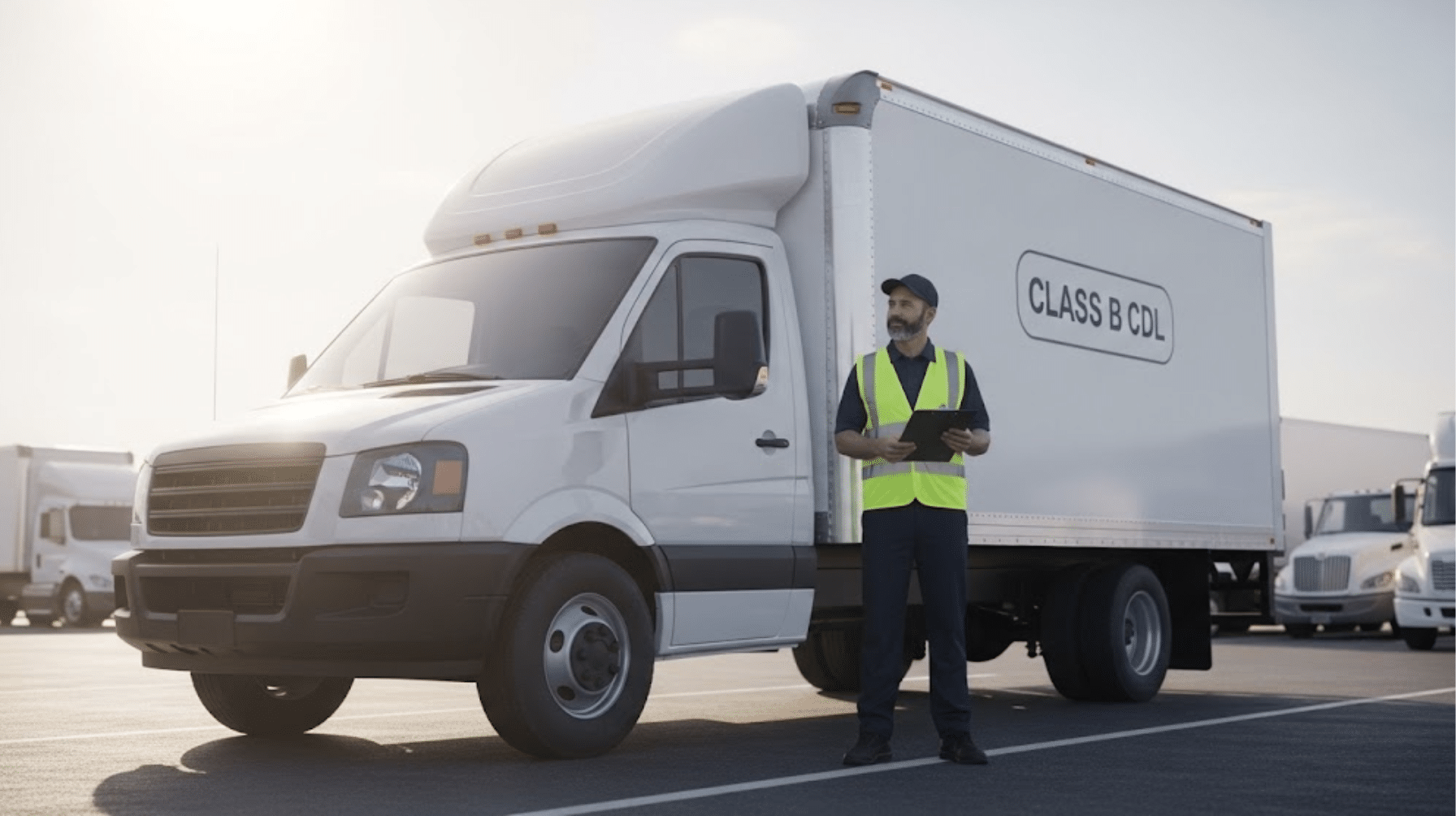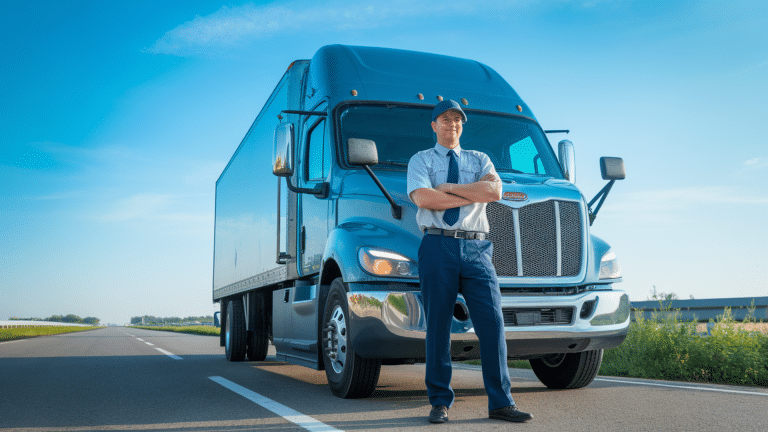When I first heard about Class B trucks, I had no idea what made them different. But after some research, I found out they’re a big part of the driving world.
If you’re thinking about getting a CDL and starting a career in trucking, it’s worth learning what a Class B license lets you do.
In this blog, I’ll explain what Class B trucks are, what jobs you can get with this license, and how to earn it.
I’ll keep things simple and clear so you can understand the basics and decide if it’s the right path for you.
Whether you want to drive a school bus, dump truck, or delivery truck, Class B could be a great choice.
What Is a Class B CDL License?

A Class B CDL is a commercial driver’s license designed for individuals who wish to operate heavy vehicles that don’t require a Class A CDL.
It applies to vehicles with a gross vehicle weight rating (GVWR) of 26,001 pounds or more and is essential for driving vehicles that transport passengers or cargo in a commercial capacity.
Vehicles You Can Drive with a Class B CDL
With a Class B CDL, one is authorized to drive a variety of vehicles, including:
- Single vehicles that have a GVWR of 26,001 pounds or more
- Buses: This includes both city transit and charter buses
- Large trucks: Such as delivery trucks, garbage trucks, and dump trucks
- Cargo transport vehicles: Including straight trucks, box trucks, and some specialty vehicles
Additionally, a Class B CDL allows for the operation of vehicles that transport hazardous materials, as long as the necessary endorsements are obtained.
This makes it a versatile license for those interested in working with commercial vehicles without requiring the more advanced Class A CDL.
Benefits of Obtaining a Class B CDL
Holding a Class B CDL comes with several advantages, particularly for those pursuing a career in the commercial driving field. Some of the key benefits include:
1. Access to a Variety of Jobs
One of the biggest benefits of holding a Class B CDL is the wide range of job opportunities available. With this license, individuals can pursue roles such as:
- Bus driver: Operating city buses, school buses, or charter buses
- Truck driver: Driving delivery trucks, dump trucks, or cargo vans
- Emergency vehicle driver: Driving fire trucks and ambulances
The variety of roles provides flexibility and makes it an attractive option for those seeking diverse career choices.
2. Higher Earning Potential
Class B CDL holders generally earn more than those without a commercial driver’s license. Depending on the type of job and level of experience, salaries can range from $30,000 to $70,000 annually.
For example, bus drivers and delivery truck drivers can earn competitive wages due to the specialized nature of their work.
3. Job Stability and Growth
The demand for commercial drivers, especially those with a Class B CDL, continues to rise. With the growth of e-commerce and the ongoing need for public transportation, many industries require qualified drivers.
This demand leads to job stability and opportunities for career growth. The commercial driving field offers long-term employment prospects for those who hold a CDL.
4. Opportunity for Further Qualifications
A Class B CDL also provides the opportunity to pursue additional qualifications over time. If desired, individuals can transition to a Class A CDL, which can lead to even more job opportunities.
The Class B CDL acts as a stepping stone for those looking to advance within the commercial driving industry.
How to Obtain a Class B CDL License
The process of obtaining a Class B CDL is straightforward but requires meeting specific criteria and passing various tests. While the details may vary by state, the general steps to obtain a Class B CDL are similar across the U.S.
1. Meet Eligibility Requirements
Before applying for a Class B CDL, individuals must meet the following eligibility criteria:
- Age requirement: Applicants must be at least 18 years old to drive within their state (intrastate) or 21 years old to drive across state lines (interstate).
- Valid driver’s license: A valid, non-commercial driver’s license is required.
- Medical certification: A physical exam must be passed to ensure fitness for driving a large vehicle. This includes vision, hearing, and overall health checks. Upon passing, a certified medical examiner will issue a Medical Examiner’s Certificate.
- Clean driving record: A driving record free from major traffic violations or criminal offenses is required. Minor violations may be overlooked, but this can vary by state.
2. Complete CDL Training
Though not mandatory, completing formal CDL training is strongly recommended.
Training provides comprehensive knowledge of commercial driving and significantly increases the chances of passing the required exams.
Training programs typically include both classroom instruction and behind-the-wheel practice, and can be found at community colleges, vocational schools, or specialized CDL training centers.
3. Pass the Knowledge Test
After completing training, applicants must pass a written knowledge test. This test covers a wide range of topics, including road safety, traffic laws, and the specifics of operating large vehicles.
Studying the CDL manual from the respective state and taking practice tests are helpful preparation methods.
4. Pass the Skills Test
Following the knowledge test, applicants must take a skills test, which typically consists of three parts:
- Pre-trip inspection: Applicants demonstrate their knowledge of the vehicle and how to check it for safety.
- Basic control skills test: Applicants are tested on their ability to control the vehicle, such as backing up, parallel parking, and making turns.
- On-road driving test: Applicants drive the vehicle on public roads to demonstrate their ability to operate the vehicle safely in traffic.
5. Obtain Endorsements (Optional)
If the goal is to drive specialized vehicles such as a passenger bus or a vehicle carrying hazardous materials, additional endorsements must be obtained.
These endorsements require passing specific tests. Common endorsements for Class B CDL holders include:
- P: Passenger (for buses)
- S: School bus (for school buses)
- H: Hazardous materials (for transporting hazardous cargo)
6. Receive the Class B CDL
After passing all necessary tests and meeting the qualifications, the Class B CDL will be issued. This is an important step toward securing a job in the commercial driving industry.
Along with the CDL, a medical certificate will be issued, which must be carried while driving.
Common Mistakes to Avoid When Applying for a Class B CDL
When preparing to obtain a Class B CDL, certain common mistakes should be avoided to ensure the process goes smoothly:
- Skipping the study process: It’s crucial to study the state’s CDL manual and practice with sample tests. Relying solely on driving experience could result in missing important information on the exam.
- Neglecting medical certification: Completing the medical exam early is important, as failing the exam could delay the CDL application.
- Inadequate vehicle preparation: Before the skills test, ensure that the vehicle being used is properly maintained and ready for inspection. A poorly maintained vehicle can result in failure.
Conclusion
Obtaining a Class B CDL opens up numerous career opportunities, particularly for individuals with the right experience in commercial driving.
The license provides access to jobs in public transportation, delivery, and emergency services, offering both job stability and growth potential.
The process involves completing written and skills tests, obtaining medical certification, and potentially adding endorsements, all of which provide valuable qualifications for a successful career.
With the right preparation and experience, the Class B CDL is a crucial step toward a fulfilling and sustainable career in commercial driving.








